Guajillo-Ancho Orange Chili Paste Shrimp
Recipe Overview: Guajillo-Ancho Orange Chili Paste Shrimp Dried guajillo and ancho chilies toasted, rehydrated, and blended with fresh orange juice, garlic, and spices into a smoky-citrus paste for marinating and glazing grilled shrimp
Guajillo-Ancho Orange Chili Paste Shrimp
Dried guajillo and ancho chilies toasted, rehydrated, and blended with fresh orange juice, garlic, and spices into a smoky-citrus paste for marinating and glazing grilled shrimp
Ingredients
For the Guajillo-Ancho Orange Paste:
- 3 dried guajillo chilies, stems and seeds removed
- 2 dried ancho chilies, stems and seeds removed
- 3 cloves garlic, peeled
- 2 tbsp olive oil (or avocado oil)
- Juice and zest of 1 large orange (about ¼ cup juice)
- 1 tbsp apple cider vinegar (or lime juice)
- 1 tsp smoked paprika
- ½ tsp ground cumin
- ½ tsp Mexican oregano
- 1 tsp kosher salt
- ½ tsp black pepper
- 1 tsp brown sugar or honey (optional for balance)
- 2-3 tbsp warm water (to blend smoothly)
For the Shrimp:
- 1½-2 lbs large shrimp (16-20 count), peeled and deveined
Optional for Serving:
- Corn tortillas
- Avocado crema
- Lime wedges
- Fresh cilantro
- Pico de gallo
Guajillo-ancho orange chili paste shrimp brings together the smoky complexity of dried Mexican chilies with the bright, citrusy punch of fresh orange juice to create a marinade and glaze that transforms simple shrimp into restaurant-quality seafood. This Mexican chili shrimp recipe starts by toasting whole dried guajillo and ancho chilies to wake up their essential oils, then rehydrating them until soft enough to blend. The softened chilies get blended with fresh orange juice and zest, garlic, olive oil, vinegar, and warm Mexican spices into a thick, glossy paste with deep red color. The paste marinates peeled shrimp for twenty to thirty minutes before they hit a hot grill or griddle where the natural sugars caramelize into a lacquered glaze with charred edges.
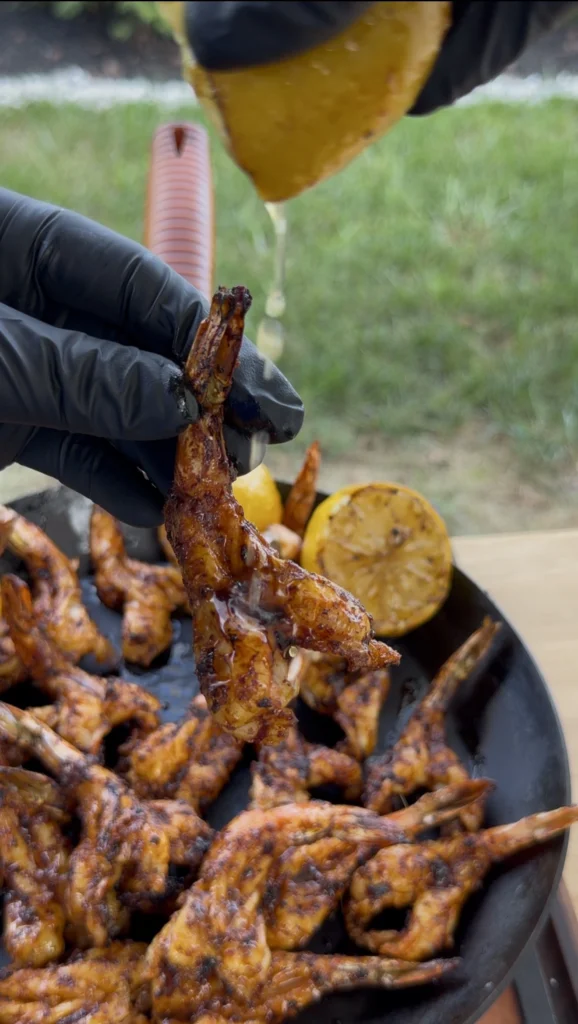
What makes this orange chili shrimp recipe special is how the fruity acidity of orange juice balances the earthy, smoky depth of the dried chilies. Guajillo chilies provide bright, tangy heat with subtle berry notes, while ancho chilies contribute sweet, raisin-like richness with pronounced smokiness. The orange juice doesn’t just add flavor – its citric acid helps tenderize the shrimp’s proteins while the natural sugars enhance caramelization during cooking. As the paste reduces on the hot cooking surface, it transforms into a glossy glaze that coats each shrimp with concentrated flavor.
This grilled shrimp with chili paste recipe delivers complex, layered flavors that taste like hours of work but come together in just twenty minutes of active time. The versatile paste works as a marinade, basting sauce, or finishing glaze, and keeps refrigerated for up to a week for multiple uses. Whether you’re making shrimp tacos, rice bowls, or simply serving grilled shrimp with lime wedges, this guajillo-ancho orange paste creates bold Mexican flavors that consistently impress.
Understanding Dried Mexican Chilies
Dried Mexican chilies are fundamental to authentic Mexican cooking, providing depth and complexity impossible to achieve with fresh peppers or chili powder alone. The drying process concentrates the chilies’ flavors while developing new compounds through mild oxidation and fermentation. Each variety of dried chili has distinct characteristics – different heat levels, flavor profiles, and ideal uses. Understanding these differences allows you to combine chilies strategically for balanced, complex flavor.
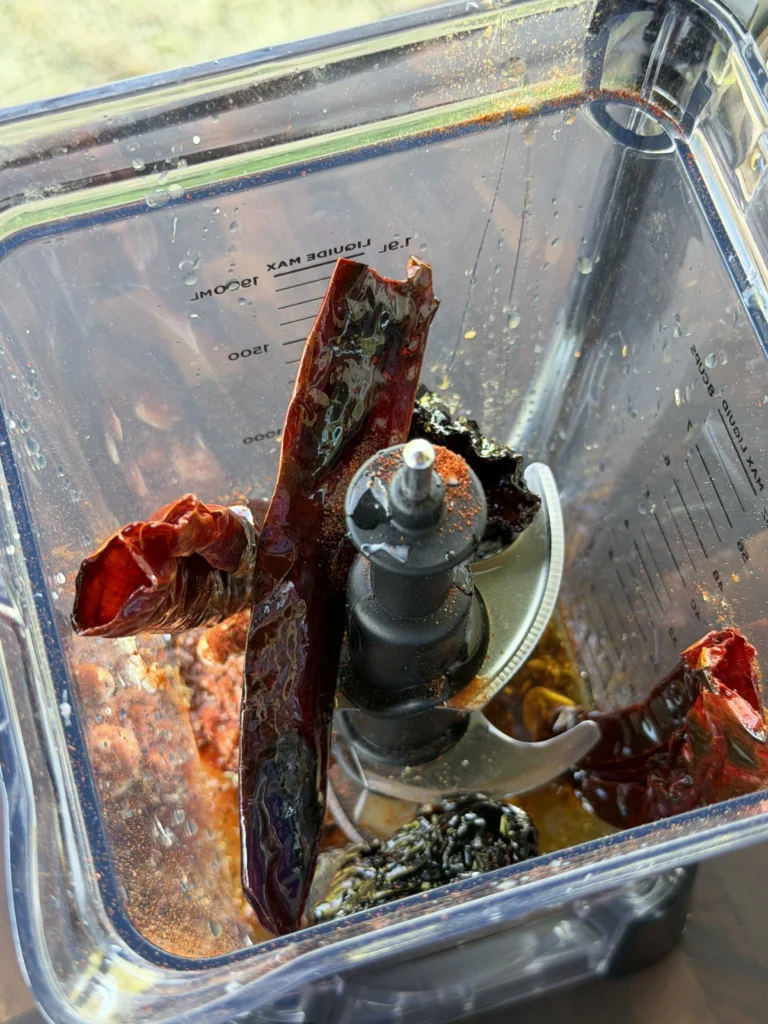
Guajillo chilies are among Mexico’s most commonly used dried peppers, prized for their bright, tangy flavor with fruity undertones. They measure moderate heat on the Scoville scale – spicy enough to be noticeable but not overwhelming. Guajillos have smooth, shiny, dark red skin and are relatively large, making them easy to work with. Their flavor profile includes notes of green tea, berries, and tomato with pleasantly sharp heat. In this recipe, guajillos provide the forward flavor and bright acidity that complements the orange juice.
Ancho chilies are dried poblano peppers with completely different character than guajillos. Anchos are wide, wrinkled, and nearly black with sweet, earthy flavor reminiscent of raisins, prunes, and chocolate. Their heat is very mild – barely perceptible to most palates. Anchos provide the smoky, sweet foundation that grounds brighter flavors. Without anchos, the paste would taste sharp and one-dimensional; without guajillos, it would taste too heavy and sweet. The combination creates balanced complexity.
Both chilies benefit from toasting before use. The brief exposure to dry heat wakes up dormant essential oils, making the chilies more aromatic and flavorful. However, burning even slightly creates bitter, acrid flavors, so the toasting must be brief – just thirty to forty-five seconds per side until fragrant. The chilies should puff slightly and smell intensely of themselves without any burnt aroma.
The Science of Rehydrating Dried Chilies
Rehydrating dried chilies isn’t just about adding back lost moisture – it’s about preparing them for blending into smooth paste. Dried chilies have tough, leathery skin that won’t break down in a blender without adequate softening. The hot water penetrates the chili’s cell walls, softening the tough outer skin while dissolving some of the pectin that holds the flesh together. This makes the chilies pliable and easy to blend.
The fifteen to twenty minute soaking time ensures complete rehydration without over-softening. Under-soaked chilies create grainy, chunky paste with bits of tough skin that never fully break down. Over-soaking doesn’t harm texture but can leach flavor into the soaking water. This is why some recipes call for using soaking liquid in the blend – it contains dissolved flavor compounds from the chilies. However, it can also contain bitterness from the seeds and stems, so use it judiciously.
Removing seeds and stems before soaking is optional but recommended for smoother paste and controlled heat. Most of a dried chili’s heat resides in the seeds and the pale membrane (placenta) inside the chili. Removing them creates milder paste while also eliminating the bitter compounds concentrated in seeds. The stems are woody and won’t blend smooth, so they must be removed regardless. Simply tear or cut the top off each chili and shake out the seeds.
The soaking water should be hot but not boiling – around 180-200°F. Boiling water can make the chilies mushy and cook them slightly, changing their flavor. Hot tap water or water brought to a boil then removed from heat works perfectly. Weight the chilies down with a plate if they float, ensuring complete submersion for even softening.
How Orange Enhances Chili Flavor
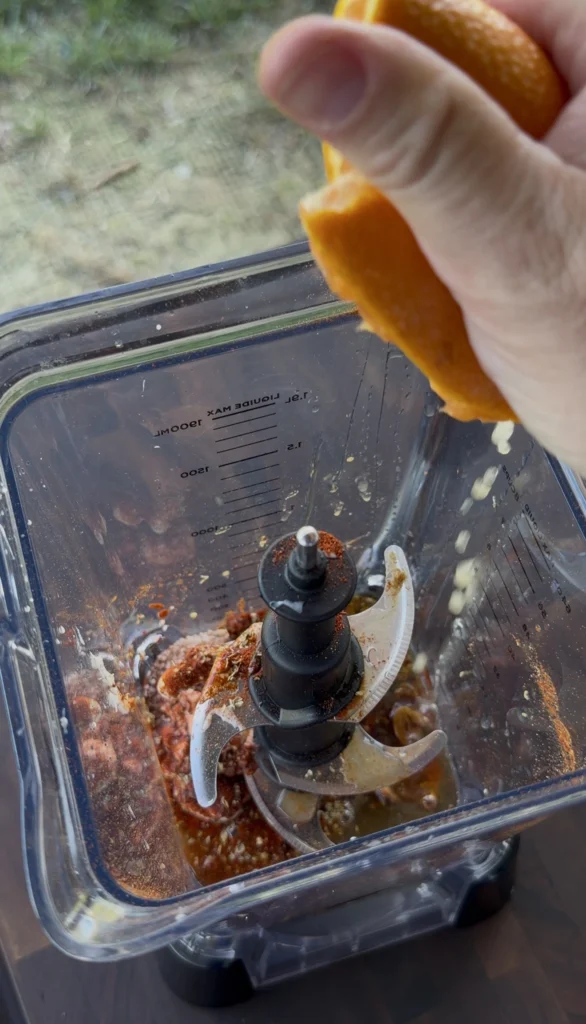
Orange juice and zest provide more than just citrus flavor – they fundamentally alter how we perceive the chilies while contributing functional benefits. The citric acid in orange juice brightens the earthy, deep flavors of dried chilies, making them taste more vibrant and complex. Without acid, the chili paste would taste flat and heavy; the orange lifts everything into clarity. This is similar to how a squeeze of lime transforms Mexican food from good to great.
Orange also provides natural sugars that caramelize during cooking, creating glossy glaze and complex sweetness. The fructose and glucose in orange juice react with amino acids in the shrimp through Maillard reaction, developing hundreds of new flavor compounds. This is why the shrimp develop those beautiful charred spots and lacquered appearance rather than just browning. The sugars also balance the chilies’ heat, making the dish taste more rounded than aggressive.
The aromatic compounds in orange zest – primarily limonene – add floral, perfumed notes that complement the fruity elements in guajillo chilies. Zest contains essential oils absent from the juice, providing intensity that juice alone can’t match. Using both juice and zest creates more complete orange flavor than either component alone. The oils in the zest are fat-soluble, so they dissolve into the olive oil in the paste, distributing orange aroma throughout.
Orange specifically (versus lemon or lime) provides the right flavor profile for this application. Lemon would be too sharp and medicinal, while lime would be too aggressive. Orange has gentle acidity with inherent sweetness that harmonizes with ancho chilies’ sweet, fruity character. The combination tastes distinctly Mexican – orange is traditional in many regional Mexican sauces and marinades.
The Role of Supporting Ingredients
Garlic provides pungent, savory depth that anchors the sweeter, brighter elements. Raw garlic has sharp, aggressive flavor, but when blended with acidic ingredients and then cooked, it mellows into sweet, aromatic character. Three cloves provide noticeable garlic presence without overwhelming the chilies and orange. The garlic also contains compounds that enhance savory (umami) perception, making the paste taste more substantial and satisfying.
Olive oil serves multiple purposes beyond fat content. It helps the paste blend smoothly by providing liquid that carries flavor compounds. The fat makes the paste coat shrimp more evenly than water-based marinade would, creating better coverage. Oil also facilitates heat transfer during cooking, helping the paste caramelize rather than burn. Additionally, many of the aromatic compounds in chilies and orange zest are fat-soluble, meaning they dissolve into oil where they can be tasted more readily.
Apple cider vinegar adds sharp acidity that brightens the paste beyond what orange juice alone provides. The acetic acid in vinegar is stronger than citric acid, giving the paste more tangy punch. Vinegar also acts as a preservative, helping the paste keep longer in the refrigerator. The slight apple flavor in cider vinegar (versus white vinegar) complements the fruit notes in the chilies. Lime juice can substitute if preferred, though it changes the flavor profile slightly.
Smoked paprika, cumin, and Mexican oregano provide the warm spice notes that define Mexican flavor profiles. Smoked paprika reinforces the natural smokiness in ancho chilies while adding color intensity. Cumin contributes earthy, slightly bitter notes with warming aromatics. Mexican oregano (different from Mediterranean oregano) has citrusy, floral character that’s traditional in Mexican cooking. Together, these spices create the familiar, comforting warmth of Mexican cuisine.
Brown sugar or honey balances the paste if the chilies are particularly bitter or if you want a sweeter glaze. This is optional – taste the paste after blending and add sweetener only if needed. Natural sugars also enhance caramelization during cooking, creating a more lacquered, glossy finish on the shrimp.
Why Simmering Improves the Paste
The optional step of simmering the blended paste for three to four minutes significantly improves flavor by cooking the raw garlic, blooming the spices, and integrating the orange into the chili base. Raw garlic has sharp, almost burning heat that’s unpleasant in large quantities. Brief cooking mellows this harshness while developing sweet, nutty notes. The garlic’s sulfur compounds volatilize, becoming aromatic rather than pungent.
Heating also blooms the ground spices – cumin, paprika, and oregano. Dry spices contain essential oils that are released and transformed by heat. Brief cooking makes them taste more complex and integrated rather than tasting like raw spice powder sprinkled on food. The heat breaks down cell walls in the dried herbs, releasing aromatic compounds that were previously locked inside.
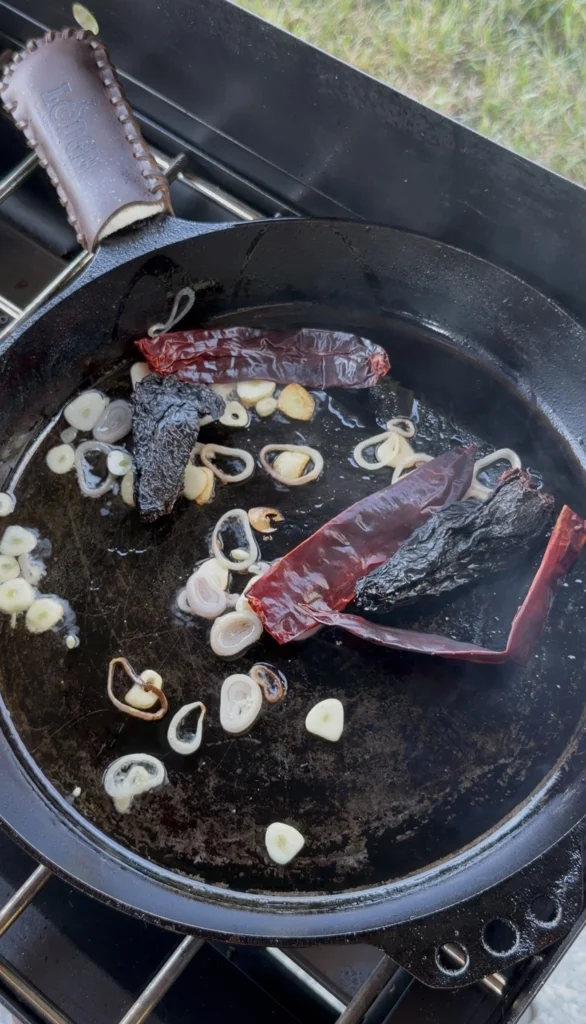
Simmering reduces excess water, concentrating flavors and thickening the paste’s consistency. A thicker paste clings better to shrimp during marinating and cooking rather than pooling in the bottom of the container. The heat also helps emulsify the oil with the water-based ingredients, creating more stable, uniform texture. The paste should be thick enough to coat the back of a spoon – similar to barbecue sauce consistency.
The cooking step also melds the orange juice with the chili base more completely. Raw orange juice can taste distinct from the chilies, but heating integrates everything into cohesive flavor where individual components are harder to identify separately. This creates smoother, more professional-tasting sauce. However, this step is optional – uncooked paste still works well if you’re short on time.
Marinating Shrimp Properly
Shrimp require much shorter marinating time than other proteins because they’re small, delicate, and can be “cooked” by acid if left too long. Twenty to thirty minutes is the sweet spot – long enough for flavor penetration but short enough to avoid textural issues. The citric acid in orange juice begins denaturing (unfolding) the proteins in shrimp almost immediately, similar to the “cooking” that happens in ceviche. Too much time in acidic marinade creates mushy, opaque shrimp before they ever hit the heat.
The acid does serve beneficial purposes in moderation. It helps tenderize the shrimp slightly while opening up the protein structure to absorb flavor. The salt in the paste also helps season the shrimp throughout rather than just on the surface. Salt penetrates relatively quickly through diffusion, seasoning the meat within twenty minutes. The oil in the paste helps fat-soluble flavor compounds penetrate while creating a coating that prevents moisture loss during cooking.
Use peeled and deveined shrimp to maximize marinade contact and make eating easier. The shell would prevent the paste from reaching the meat, wasting much of the flavor. Size matters – large shrimp (16-20 count per pound or bigger) work best because they’re easier to handle and less likely to overcook. Smaller shrimp cook so quickly they can go from perfect to rubbery in seconds. Thawed frozen shrimp work perfectly – pat them dry before marinating to remove excess water.
Marinate in the refrigerator rather than at room temperature for food safety. Shrimp are particularly prone to bacterial growth at warm temperatures. The cold environment also slows the acid’s denaturing effect slightly, giving you more control over texture. Toss the shrimp in the paste to coat evenly, then cover and refrigerate. Reserve some paste for basting during cooking – don’t use paste that touched raw shrimp.
Ingredients
For the Guajillo-Ancho Orange Paste:
- 3 dried guajillo chilies, stems and seeds removed
- 2 dried ancho chilies, stems and seeds removed
- 3 cloves garlic, peeled
- 2 tbsp olive oil (or avocado oil)
- Juice and zest of 1 large orange (about ¼ cup juice)
- 1 tbsp apple cider vinegar (or lime juice)
- 1 tsp smoked paprika
- ½ tsp ground cumin
- ½ tsp Mexican oregano
- 1 tsp kosher salt
- ½ tsp black pepper
- 1 tsp brown sugar or honey (optional for balance)
- 2-3 tbsp warm water (to blend smoothly)
For the Shrimp:
- 1½-2 lbs large shrimp (16-20 count), peeled and deveined
Optional for Serving:
- Corn tortillas
- Avocado crema
- Lime wedges
- Fresh cilantro
- Pico de gallo
Step-by-Step Instructions
Toast the Dried Chilies
Place a dry skillet over medium heat and let it warm for one to two minutes. While the skillet heats, remove the stems from the guajillo and ancho chilies by tearing or cutting them off at the top. Shake out as many seeds as possible – you can leave a few seeds if you want extra heat, but removing most creates smoother paste with better flavor.
Once the skillet is hot, add the cleaned chilies in a single layer. Press them gently against the hot surface with a spatula for thirty to forty-five seconds, then flip and press the other side for another thirty to forty-five seconds. You should smell the chilies becoming aromatic and fragrant – a sweet, slightly fruity aroma that’s distinctly different from their dried scent. The chilies may puff slightly and darken just a shade. Don’t let them smoke or char – burnt chilies taste bitter and will ruin the paste. If they start smoking, immediately remove them from heat.
Transfer the toasted chilies to a heat-safe bowl immediately to stop the cooking. This brief toasting wakes up the essential oils and makes the final paste more aromatic and flavorful. Don’t skip this step – untoasted chilies create flatter, less complex paste.
Rehydrate the Toasted Chilies
Pour hot water (just off the boil, around 180-200°F) over the toasted chilies to cover them completely. Place a small plate or bowl on top of the chilies to weight them down and keep them submerged – they’ll float otherwise. Let soak for fifteen to twenty minutes until the chilies are soft and pliable. They should feel like soft leather rather than stiff cardboard when properly rehydrated.
After soaking, drain the chilies in a colander, reserving about a quarter cup of the soaking liquid in case you need it for blending. Gently squeeze excess water from the chilies – you want them soft but not waterlogged. The drained, softened chilies are now ready to blend.
Blend the Chili-Orange Paste
Add the rehydrated chilies to a blender along with the three garlic cloves, two tablespoons of olive oil, the juice and zest of one large orange (about a quarter cup of juice plus the zest), one tablespoon of apple cider vinegar, one teaspoon of smoked paprika, half teaspoon of ground cumin, half teaspoon of Mexican oregano, one teaspoon of kosher salt, half teaspoon of black pepper, and one teaspoon of brown sugar or honey if using.
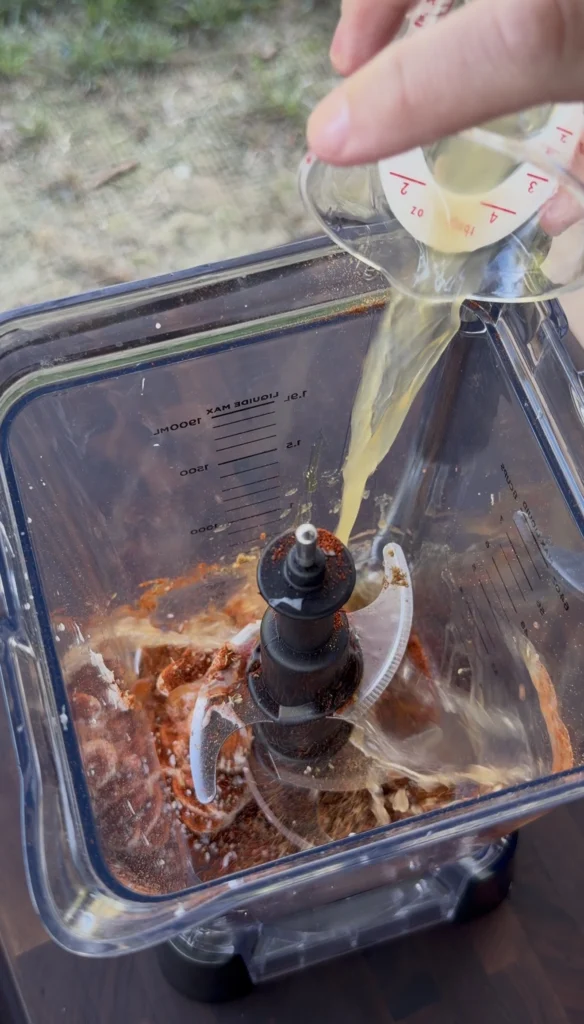
Add two to three tablespoons of warm water (or some of the reserved chili soaking liquid). Start blending on low speed, then gradually increase to high. Blend for one to two minutes, stopping to scrape down the sides as needed, until the mixture is completely smooth and uniform. The paste should be thick and glossy with deep red-orange color – somewhere between ketchup and tomato paste in consistency. If it’s too thick to blend smoothly, add warm water one tablespoon at a time until it reaches the right consistency.
Taste the paste carefully (it’s raw, so just a tiny taste). It should be balanced between smoky, sweet, spicy, tangy, and citrusy. Adjust seasoning if needed – more salt if it tastes flat, more vinegar if it needs brightness, more sugar if it’s too bitter. Remember that flavors will concentrate during cooking, so slightly under-seasoned is better than over-seasoned.
Optional: Simmer for Deeper Flavor
For the best flavor, transfer the blended paste to a small saucepan with one teaspoon of oil. Place over medium-low heat and cook, stirring constantly, for three to four minutes. The paste will darken slightly, thicken, and smell more aromatic as the raw garlic cooks and the spices bloom. This step integrates all the flavors more completely and removes any raw edge from the garlic. The paste should bubble gently but not spatter – reduce heat if it’s splattering.
After cooking, remove from heat and let cool to room temperature. The cooked paste will have deeper, more complex flavor than raw paste. This step is optional but highly recommended if you have time. If you skip it, the paste will still be delicious, just slightly less refined.
Marinate the Shrimp
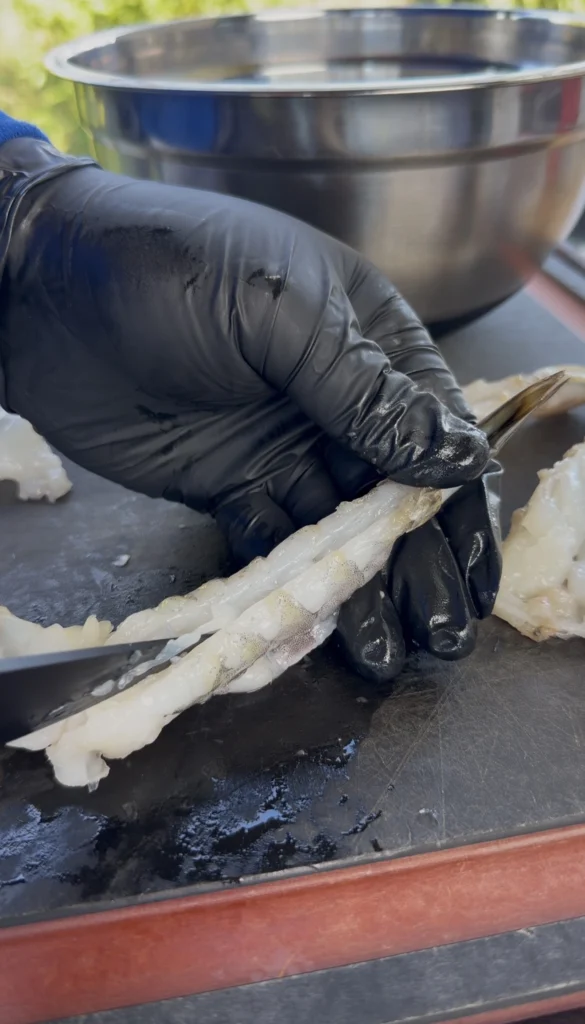
Pat the peeled and deveined shrimp completely dry with paper towels. Any excess moisture will dilute the marinade and prevent it from adhering properly. Place the dried shrimp in a medium bowl.
Preheat the Grill or Griddle
While the shrimp marinate, preheat your grill or griddle to medium-high heat. For a grill, you want direct heat around 400-450°F. For a griddle or cast iron skillet, heat over medium-high heat for five minutes until hot. The cooking surface should be hot enough that water drops sizzle and evaporate immediately but not so hot that the sugar in the paste burns before the shrimp cook through.
Lightly oil the grill grates or griddle surface to prevent sticking. Shrimp don’t have much fat, so they’ll stick to dry surfaces. Use a paper towel dipped in oil and held with tongs to wipe the grates, or drizzle oil directly on a griddle and spread with a spatula.
Grill or Griddle the Shrimp
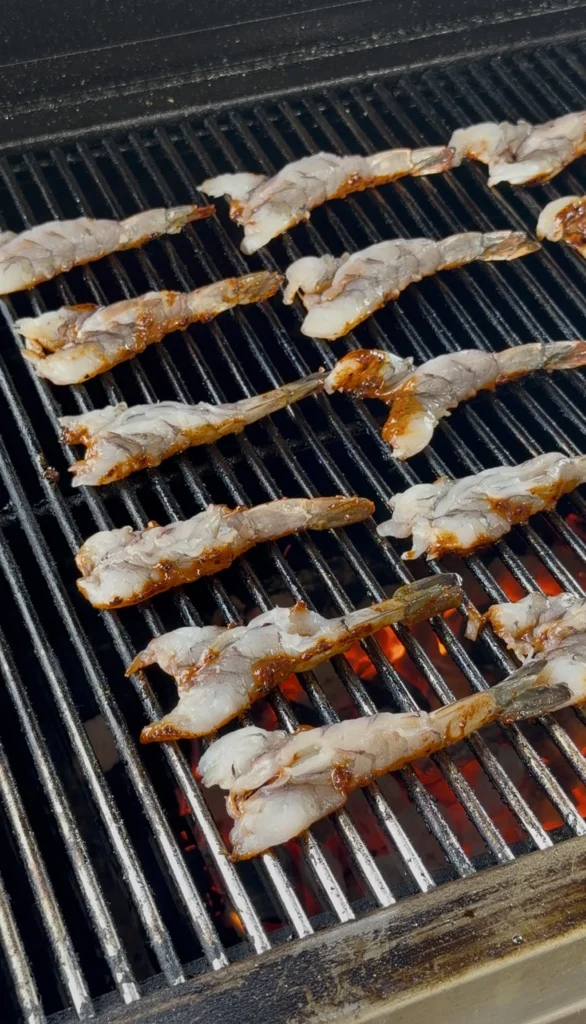
Remove the shrimp from the refrigerator. If grilling, thread them onto skewers for easier handling, or place them directly on the grates perpendicular to the bars so they don’t fall through. If using a griddle, arrange the shrimp in a single layer with some space between them.
Cook for two to three minutes on the first side without moving them. The shrimp should develop charred spots and the paste should caramelize into a glossy glaze. Brush with some of the reserved clean paste during cooking for extra glaze. Flip the shrimp and cook another two to three minutes on the second side until the shrimp are opaque throughout and have reached an internal temperature of 120-145°F.
Add the orange chili paste to the shrimp while on the grill.
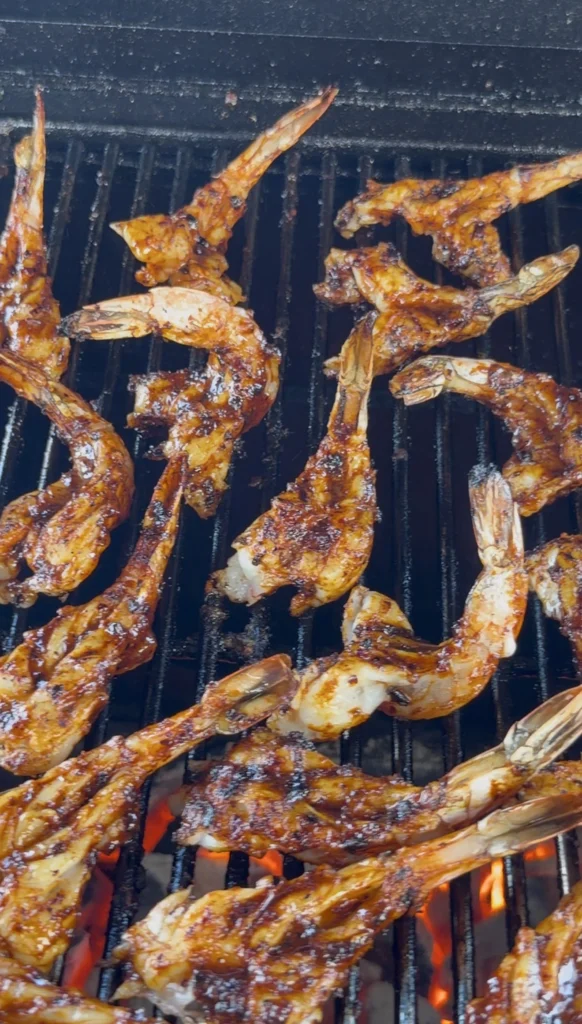
Watch carefully – shrimp cook quickly and can go from perfect to overcooked in thirty seconds. They’re done when they’ve turned from translucent gray to opaque pink-white and have curled into a C-shape. If they curl into a tight O-shape, they’re overcooked. The exterior should be deeply caramelized with charred spots where the paste has concentrated and burned slightly. This char adds flavor – it’s desirable rather than a mistake.
Serve Immediately
Transfer the grilled shrimp to a serving platter. Brush with any remaining reserved paste for extra gloss and flavor. Garnish with fresh cilantro and serve with lime wedges for squeezing. The shrimp should be juicy and tender with intense smoky-citrus flavor and beautiful deep red color.
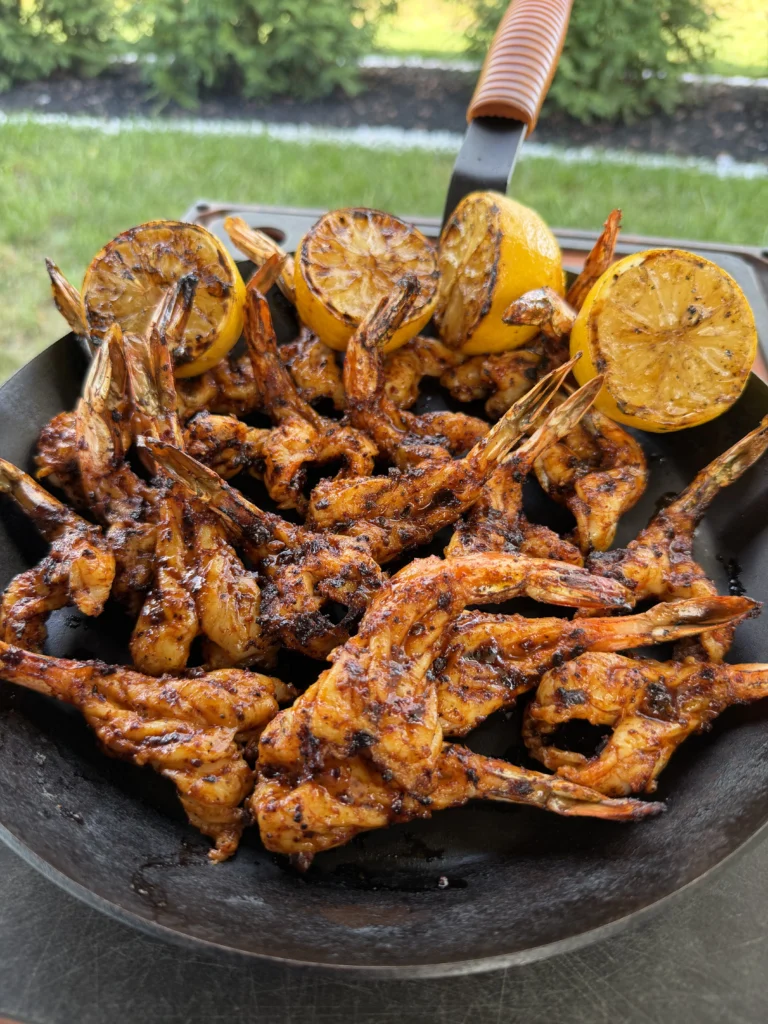
Serve the shrimp in warm corn tortillas with avocado crema, or over rice with black beans and pico de gallo, or simply with lime wedges and cold beer. The paste-glazed shrimp are the star – they need minimal accompaniment. Any leftover paste can be refrigerated for up to a week and used for other proteins or as a sauce base.
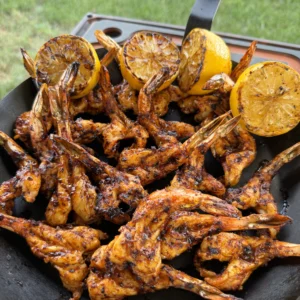
Guajillo-Ancho Orange Chili Paste Shrimp
Ingredients
- For the Guajillo-Ancho Orange Paste:
- – 3 dried guajillo chilies stems and seeds removed
- – 2 dried ancho chilies stems and seeds removed
- – 3 cloves garlic peeled
- – 2 tbsp olive oil or avocado oil
- – 1 large orange juice and zest, about ¼ cup juice
- – 1 tbsp apple cider vinegar or lime juice
- – 1 tsp smoked paprika
- – ½ tsp ground cumin
- – ½ tsp Mexican oregano
- – 1 tsp kosher salt
- – ½ tsp black pepper
- – 1 tsp brown sugar or honey optional for balance
- – 2-3 tbsp warm water to blend smoothly
- For the Shrimp:
- – 1½-2 lbs large shrimp 16-20 count, peeled and deveined
- Optional for Serving:
- – Corn tortillas
- – Avocado crema
- – Lime wedges
- – Fresh cilantro
- – Pico de gallo
Instructions
- Place a dry skillet over medium heat. Remove stems from the guajillo and ancho chilies and shake out most of the seeds. Once the skillet is hot, add the cleaned chilies in a single layer. Press them gently against the surface with a spatula for 30-45 seconds per side until aromatic and fragrant. Don’t let them smoke or char. Transfer immediately to a heat-safe bowl.
- Pour hot water (just off the boil, around 180-200°F) over the toasted chilies to cover completely. Place a small plate on top to keep them submerged. Let soak for 15-20 minutes until soft and pliable. Drain in a colander, reserving about ¼ cup of soaking liquid. Gently squeeze excess water from the chilies.
- Add the rehydrated chilies to a blender along with garlic, olive oil, orange juice and zest, apple cider vinegar, smoked paprika, cumin, Mexican oregano, salt, black pepper, and brown sugar if using. Add 2-3 tablespoons warm water or reserved soaking liquid. Blend on high for 1-2 minutes until completely smooth and glossy. The paste should be thick, similar to barbecue sauce consistency. Taste and adjust seasoning as needed.
- Transfer the blended paste to a small saucepan with 1 teaspoon oil. Cook over medium-low heat, stirring constantly, for 3-4 minutes until the paste darkens slightly, thickens, and becomes more aromatic. The raw garlic will cook and the spices will bloom. Remove from heat and let cool to room temperature. This step is optional but recommended for best flavor.
- Pat the peeled and deveined shrimp completely dry with paper towels. Reserve 2-3 tablespoons of the chili paste in a separate bowl for basting. Toss the shrimp with 3-4 tablespoons of paste in a medium bowl until evenly coated. Cover and refrigerate for 20-30 minutes. Don’t marinate longer than 45 minutes or the acid will make the shrimp mushy.
- Preheat your grill or griddle to medium-high heat (400-450°F). Lightly oil the cooking surface. Remove shrimp from marinade and place in a single layer on the hot surface. Cook 2-3 minutes per side without moving, brushing with reserved clean paste during cooking. The shrimp should develop charred spots and the paste should caramelize into a glossy glaze. Cook until opaque throughout and curled into a C-shape, reaching 120-145°F internal temperature.
- Transfer grilled shrimp to a serving platter. Brush with any remaining reserved paste for extra gloss. Garnish with fresh cilantro and serve with lime wedges. Serve in warm corn tortillas with avocado crema, over rice with beans, or simply with lime wedges. The paste-glazed shrimp should be juicy, tender, and deeply flavored.
Notes
– Don’t marinate shrimp longer than 30-45 minutes
– Reserve some paste for basting – never use paste that touched raw shrimp
– Large shrimp (16-20 count) work best and are less likely to overcook
– The paste keeps refrigerated for up to 1 week
– Use paste for other proteins: chicken thighs (2-3 hours), salmon (20-30 min)
– For extra heat, add a chipotle pepper in adobo to the paste
– For milder version, use only 2 guajillo chilies
FAQ
Can I use fresh chilies instead of dried?
Fresh chilies have completely different flavor profiles than dried – they’re grassy and vegetal rather than deep and complex. This recipe specifically relies on the concentrated, smoky flavors that develop during the drying process. Fresh poblanos won’t create the same result. However, you could add one fresh jalapeño to the paste if you want extra heat and green pepper flavor alongside the dried chilies.
What if I can’t find guajillo or ancho chilies?
Check the international aisle of larger grocery stores, Mexican markets, or order online – they’re widely available and inexpensive. If absolutely necessary, you can substitute other dried chilies: New Mexico chilies for guajillo, or pasilla chilies for ancho. Avoid using chili powder as a substitute – it won’t provide the same depth, texture, or authentic flavor.
How spicy is this dish?
As written, it’s moderately spicy – noticeable heat but not overwhelming. Guajillo chilies have moderate heat while ancho chilies are very mild. Removing all seeds makes it milder, while leaving some seeds increases heat. You can also add a chipotle pepper in adobo to the paste for significant extra heat and smokiness, or reduce the guajillos to two if you’re sensitive to spice.
Can I use this paste for other proteins?
Absolutely – this paste is incredibly versatile. It works beautifully on grilled chicken thighs, pork chops, salmon, scallops, or even vegetables like cauliflower or mushrooms. Adjust marinating time based on the protein: chicken can handle two to three hours, while fish should marinate no more than twenty to thirty minutes like shrimp. The paste also makes an excellent sauce for tacos or burritos.
My paste is grainy – what did I do wrong?
The chilies weren’t rehydrated enough, or your blender isn’t powerful enough to break down the tough skins completely. Make sure the chilies soak for the full twenty minutes until very soft. If using a less powerful blender, you may need to blend longer (three to four minutes) or strain the paste through a fine-mesh sieve to remove any remaining bits of skin for silky-smooth texture.
Conclusion
Guajillo-ancho orange chili paste shrimp proves that complex, restaurant-quality Mexican flavors can be achieved at home with readily available ingredients and straightforward technique. The combination of toasted dried chilies with fresh orange juice creates a marinade and glaze that’s simultaneously smoky, sweet, spicy, and bright – hitting every flavor note in perfect balance. The brief marinating time and quick cooking make this an accessible weeknight dinner that impresses far beyond the minimal effort required.
What makes this orange chili shrimp recipe so successful is how each component serves a specific purpose. Guajillo chilies provide bright, fruity heat while ancho chilies contribute sweet, smoky depth. Orange juice adds citrusy brightness that lifts the earthy chilies while its acid tenderizes the shrimp and its sugars caramelize during cooking. The supporting spices ground everything in familiar Mexican flavor territory. Together, these elements create complex, layered taste that makes simple grilled shrimp unforgettable.
This Mexican chili shrimp with orange paste works beautifully for casual dinners and entertaining alike. The paste keeps refrigerated for a week, making it convenient for multiple meals throughout the week. The versatility means you can use it for shrimp tacos one night, grilled chicken the next, and salmon the night after. Master this technique of toasting, rehydrating, and blending dried chilies, and you’ll unlock authentic Mexican flavors that elevate everything you cook.
If you’re looking for more recipes , click the link! Check out all of our grilling recipes here for more steak, seafood, and BBQ favorites that are perfect for your next cookout.
COMMON ITEMS USED IN THESE RECIPES
Hasty Bake Charcoal Grill and Smoker
Knitted Gloves
Food Processor
Cast Iron Skillet
Meater +
Upgrade Your Meat Game with Grill Nation x Linz Heritage Angus
If you really want to take your grilling and cooking to the next level, you need to check out our collaboration with Linz Heritage Angus. We’ve partnered with them to bring you some of the best beef you can get your hands on.
Linz Heritage Angus isn’t your typical grocery store meat. These guys are the real deal – they raise their cattle the right way, and you can taste the difference in every bite. We’re talking about beef that’s been dry-aged to perfection, with marbling that makes your mouth water just looking at it.
Check out these premium cuts that’ll change how you think about beef:
Premium Ribeye Steaks – Perfect for special occasions
Dry-Aged Beef Selection – Take your grilling to the next level
Ground Beef & Burger Blends – The foundation of great BBQ
Use code GN15 at checkout for 15% off your first order. Trust me, once you try Linz Heritage Angus, you’ll never want to go back to regular store-bought beef.